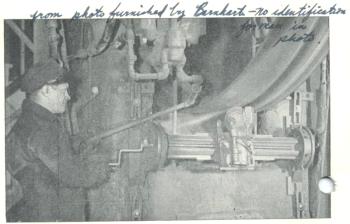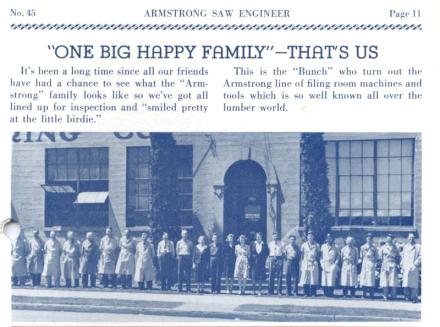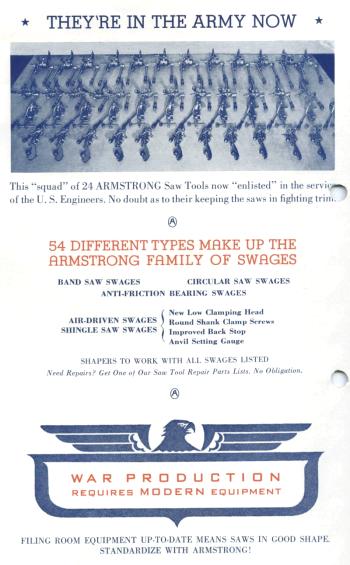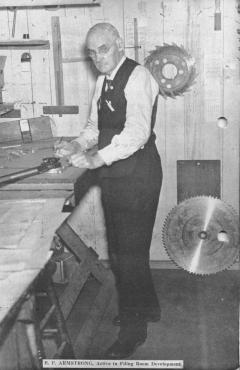
The manufacturers of the original Barnhart Band Wheel Grinder, which made band wheel grinding history when first introduced in 1915, have a new machine on the market, their 1941 Model.
Mr. W. C. Barnhart, the manufacturer, makes this statement:
"Even more accurate and easy to use, this new machine will deliver a free and faster grinding action making accuracy obtainable in less time and with less effort.
The photograph (above) shows this new machine in use in the plant of the St. Regis Paper Co., at Tacoma, Washington. At the time this photograph was taken the grinding wheel was taking not to exceed a medium depth cut. Note the volume of sparks. The band wheels on this mill are 9 ft. diameter, width of face 15 in. The circumference of the lower band wheel was reduced 3/8". The 6" x 2" grinding wheel during its use in grinding this one band wheel was reduced in diameter not to exceed 1/64". At this rate, one grinding wheel will grind both of the band wheels on this mill at least 85 times.
Mr. William Kelly, the saw filer (who, by the way, does not appear in this illustration) having accuracy as his principal objective, did not make any deep cuts on this band wheel. This accounts in some measure for the small grinding wheel wear. Mr. Kelly said that the actual grinding time was not to exceed 2-1/2 hours, and as to accuracy the job was practically perfect. The necessary reduction of 3/8" in the circumference of the lower band wheel shows that it was badly worn."
Check the coupon on page 13 for full details of this new Barnhart Band Wheel Grinder.



1865-1942
It is with extreme regret that we announce the death on October 16, 1942, at Portland, Oregon, of E. P. Armstrong, Founder and President of the company which bears his name.
Born in England, Mr. Armstrong came to this country when four years old, spending his boyhood in Connecticut where his father operated a waterpower sawmill and wagon spoke factory. The woodworking machinery and saws in this factory fascinated him at an early age, this being the beginning of a life work devoted to the operation and conditioning of woodcutting band and circular saws.
After several years of operating, planning and building waterpowers and sawmills, his attention was turned to saw filing at about the time band saws were coming into use. His experience took him to all lumber sections of the United States until, finally, in 1904, he located in Portland.
It was here that he organized the Armstrong Manufacturing Company and began to devote his entire time to the design and manufacture of Filing Room Equipment. In addition to taking active part in the engineering and management of the company, he edited and published, for five years, the North American Filer, a journal for the lumber mill. Over a period of twenty-five years he compiled and tabulated the Saw Engineering Bureau, consisting of information and data on the operation and care of wood-cutting saws. He also prepared and published a set of mechanical books on the same subject. Mr. Armstrong was a member of the American Society of Mechanical Engineers.
Highly regarded in the lumber industry, Mr. Armstrong had a very large circle of friends. His chief interest was devotion to his job of being useful to others — creating things of value by building better equipment for use in the lumber industry, of which he was so much a part.
Truly will his work live after him, for he gave liberally of his time, experience and counsel to his associates, enabling them to carry on and to follow the wonderful example which he so admirably set.